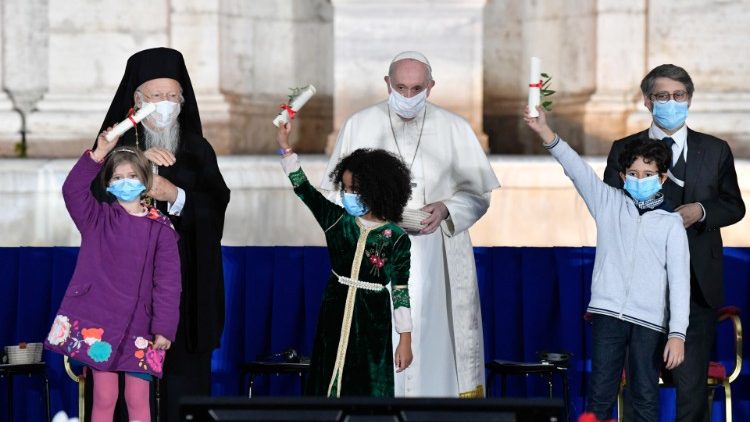 Ecumenical and interreligious Prayer for Peace Meeting in Rome (ANSA)
Ecumenical and interreligious Prayer for Peace Meeting in Rome (ANSA)
Faith and symbolism at Rome’s interreligious Meeting for Peace
A chilling list of countries at war and regions in the throes of violent tensions and persecution was read out at the end of the Prayer Service for Peace.
A candle was lit for each. Syria, Libya, Ukraine, Yemen and Afghanistan leapt to the fore. But most candles were lit for “forgotten” conflicts, lost in the indifference of a world that has more important things to deal with.
Like the war in the DRC’s Kivu region, the persecution of Christians in Burkina Faso, the simmering conflicts between India and Pakistan and on the Korean peninsula, the suffering of the people in Venezuela, in Lebanon and many, many more…
They were all read out loud and prayed for because, as the title of the event points out: “No one can be saved alone.” Especially in an interconnected and globalized world swept up in a pandemic.
It was especially moving to watch the white-clad prophet of peace, Pope Francis, slowly and painfully make his way down the 124 steep marble steps leading from the Basilica di Santa Maria in Aracoeli to the Capitoline Square. There he joined, amongst others, a Chief Rabbi, a Muslim, a Soto Zen Buddhist leader, a Sikh, a Hindu.
All of them invited by the Community of Saint Egidio that has nourished the so-called “Spirit of Assisi” since Pope Saint John Paul II gave birth to it over 30 years ago with a historic interreligious peace meeting that was heard by a world that silenced all of its weapons for the day.
A brief documentary set the tone with its stark sequence of images of people fleeing bombs with babies in their arms; of fragile rubber dinghies offloading desperate men, women and children on the shores of the Mediterranean; of parched fields where crops cannot grow and of devastating floods that have washed away the lives and the hopes of entire communities; of a menacing military parade of tanks in the heart of Europe.
The religious leaders took turns to tell the world that we are one human family and that we have to act now to save our planet and each other if there is to be a future for humanity.
Prayer, they all believe, is at the roots of peace, and their presence is a witness their will to put tradition, language and cultural differences to the side in order to pave the way to true fraternity.
The pandemic and its brutal effects were never forgotten or underestimated as they conveyed a powerful and universal message of shared responsibility struggling with masks and “clouded-up” spectacles throughout the ceremony, taking to the podium and signing their names between one “sanitization” and the next.
Powerfully symbolic was the fact that the 2020 Rome Appeal for Peace was signed on Rome’s Capitoline Hill, designed by Michelangelo at the height of the Renaissance that was based on the notion that “a man can do all things if he will”.
It is also where, in the wake of World War II, the nations that had been at war signed a pact based on a dream of unity that later came true: the dream of a United Europe.
Pope Francis was the first to light the flame of faith, hope and unity on a multi-tiered candelabra placed at the front of the stage. Sergio Mattarella, President of the Italian Republic and representing the highest level of political authority, lit the last.
The Ceremony ended with more symbolism when each speaker consigned the text of the Appeal for Peace and the sprig of an olive tree to a child representing a different part of the world. The children then walked down into the audience to – hopefully – place the Appeal in the hands of political representatives present in the Square, entrusting them with their future. (Linda Bordoni / Vatican News)
A version of this article was first published on Vatican News.


No Comments